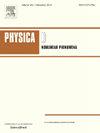A kneading diagram of chaotic switching oscillations in a Kerr cavity with two interacting light fields
IF 2.7
3区 数学
Q1 MATHEMATICS, APPLIED
引用次数: 0
Abstract
Optical systems that combine nonlinearity with coupling between various subsystems offer a flexible platform for observing a diverse range of nonlinear dynamics. Furthermore, engineering tolerances are such that the subsystems can be identical to within a fraction of the wavelength of light; hence, such coupled systems inherently have a natural symmetry that can lead to either delocalization or symmetry breaking. We consider here an optical Kerr cavity that supports two interacting electric fields, generated by two symmetric input beams. Mathematically, this system is modeled by a four-dimensional -equivariant vector field with the strength and detuning of the input light as control parameters. Previous research has shown that complex switching dynamics are observed both experimentally and numerically across a wide range of parameter values. Here, we show that particular switching patterns are created at specific global bifurcations through either delocalization or symmetry breaking of a chaotic attractor. We find that the system exhibits infinitely many of these global bifurcations, which are organized by -equivariant codimension-two Belyakov transitions. We investigate these switching dynamics by means of the continuation of global bifurcations in combination with the computation of kneading invariants and Lyapunov exponents. In this way, we provide a comprehensive picture of the interplay between different switching patterns of periodic orbits and chaotic attractors.
具有两个相互作用光场的克尔腔中混沌开关振荡的揉合图
将非线性与各子系统之间的耦合相结合的光学系统为观测各种非线性动力学提供了一个灵活的平台。此外,工程公差使得子系统可以在光波长的一小部分内相同;因此,这种耦合系统固有地具有自然对称性,可能导致离域或对称性破坏。我们在这里考虑一个光学克尔腔,它支持两个相互作用的电场,由两个对称的输入光束产生。数学上,以输入光的强度和失谐作为控制参数,用四维z2等变矢量场对系统进行建模。以往的研究表明,复杂的开关动力学在实验和数值上都可以在很宽的参数值范围内观察到。在这里,我们证明了通过混沌吸引子的离域或对称破缺在特定的全局分岔处产生特定的开关模式。我们发现系统表现出无穷多个这样的全局分岔,这些分岔由z2等变余维- 2 Belyakov跃迁组织。我们结合捏合不变量和Lyapunov指数的计算,利用全局分岔的延拓来研究这些切换动力学。通过这种方式,我们提供了周期轨道和混沌吸引子的不同开关模式之间相互作用的全面图景。
本文章由计算机程序翻译,如有差异,请以英文原文为准。
求助全文
约1分钟内获得全文
求助全文
来源期刊

Physica D: Nonlinear Phenomena
物理-物理:数学物理
CiteScore
7.30
自引率
7.50%
发文量
213
审稿时长
65 days
期刊介绍:
Physica D (Nonlinear Phenomena) publishes research and review articles reporting on experimental and theoretical works, techniques and ideas that advance the understanding of nonlinear phenomena. Topics encompass wave motion in physical, chemical and biological systems; physical or biological phenomena governed by nonlinear field equations, including hydrodynamics and turbulence; pattern formation and cooperative phenomena; instability, bifurcations, chaos, and space-time disorder; integrable/Hamiltonian systems; asymptotic analysis and, more generally, mathematical methods for nonlinear systems.
 求助内容:
求助内容: 应助结果提醒方式:
应助结果提醒方式:


